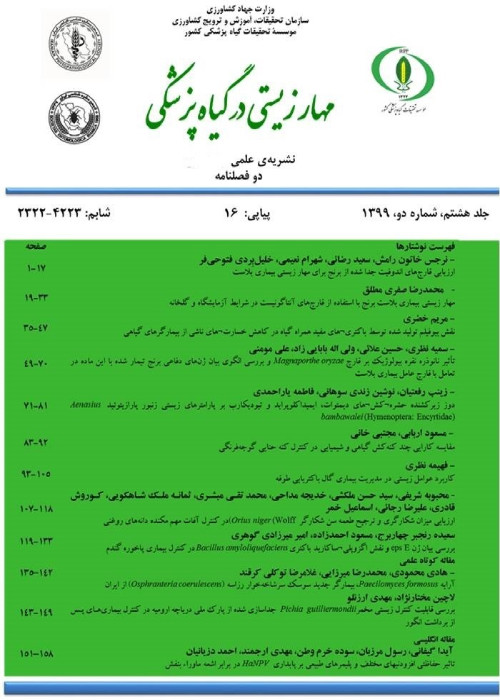Biological control of rice blast disease with native Trichoderma isolates
Author(s):
Abstract:
Rice blast caused by Magnaporthe oryzae is the most important disease of rice worldwide. Although, application of chemical pesticides can control the disease, but they cause harmful effects on environment and human health. Nowadays, biological control is considered as an alternative and safe method in plant disease management. In this study, sampling was done from soils and rice phyllosphere of paddy fields in different regions of Mazandaran province. Trichoderma spp. were isolated following dilution plating method using McFadden & Sutton’s RB-S-F selective medium, and then purified and preserved. Eighty nine Trichoderma Rice blast caused by Magnaporthe oryzae is the most important disease of rice worldwide. Although, application of chemical pesticides can control the disease, but they cause harmful effects on environment and human health. Nowadays, biological control is considered as an alternative and safe method in plant disease management. In this study, sampling was done from soils and rice phyllosphere of paddy fields in different regions of Mazandaran province. Trichoderma spp. were isolated following dilution plating method using McFadden & Sutton’s RB-S-F selective medium, and then purified and preserved. Eighty nine Trichoderma isolates were screened against M. oryzae using various methods in vitro. In dual culture test, more than 90% of Trichoderma isolates were antagonistic against pathogen. In hyperparasitism test, no coiling of Trichoderma was observed around the hyphae of M. oryzae. However, some strains caused disintegration of M. oryzae hyphae. Volatile metabolites of RP3-4 and RP3-2 strains were the most effective in inhibiting the growth rate of pathogen by 66.6%. In addition, RP7-1 strain was reduced the growth of pathogen by 93.74% and 90.62% using 20% and 5% of culture filtrate, respectively. Based on the results of in vitro studies, 16 Trichoderma isolates were selected in order to evaluate their potentials in controlling blast disease in greenhouse. According to the results of greenhouse tests, T. harzianum RP1-6 and T.harzianum RP4-2 strains were the most effective isolates in terms of reducing the severity of leaf blast disease by 100% and 99%, respectively. Furthermore, T. harzianum RP6-1 and T. virens RS7-6 with disease reduction of 98% and 97%, respectively placed in same statistical group as chemical fungicides (Carpropamid). Evaluation of population dynamics showed that the populations of Trichoderma isolates were increased or decreased during 17d in greenhouse.T. harzianum RP6-1and T. atroviride RS4-1, showed maximum increase and decrease of opulation, respectively. There was no correlation between the populations and disease control. In addition, 16 selected Trichoderma isolates were identified by morphological and molecular methods and 14, 1 and 1 isolates belonged to T. harzianum, T. virens and T. atroviride, respectively.
Language:
Persian
Published:
BioControl in Plant Protection, Volume:2 Issue: 1, 2014
Pages:
1 to 15
https://magiran.com/p1468535
دانلود و مطالعه متن این مقاله با یکی از روشهای زیر امکان پذیر است:
اشتراک شخصی
با عضویت و پرداخت آنلاین حق اشتراک یکساله به مبلغ 1,390,000ريال میتوانید 70 عنوان مطلب دانلود کنید!
اشتراک سازمانی
به کتابخانه دانشگاه یا محل کار خود پیشنهاد کنید تا اشتراک سازمانی این پایگاه را برای دسترسی نامحدود همه کاربران به متن مطالب تهیه نمایند!
توجه!
- حق عضویت دریافتی صرف حمایت از نشریات عضو و نگهداری، تکمیل و توسعه مگیران میشود.
- پرداخت حق اشتراک و دانلود مقالات اجازه بازنشر آن در سایر رسانههای چاپی و دیجیتال را به کاربر نمیدهد.
In order to view content subscription is required
Personal subscription
Subscribe magiran.com for 70 € euros via PayPal and download 70 articles during a year.
Organization subscription
Please contact us to subscribe your university or library for unlimited access!




